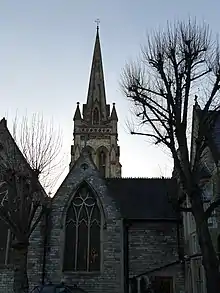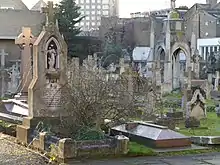St Thomas of Canterbury Church, Fulham
St Thomas of Canterbury Church, also known as St Thomas's, Rylston Road, is a Roman Catholic parish church in Fulham, central London. Designed in the Gothic Revival style by Augustus Pugin in 1847, the building is Grade II* listed with Historic England.[1] It stands at 60 Rylston Road, Fulham, next to Pugin's Grade II listed presbytery and churchyard and St Thomas's primary school, also largely by Pugin, close to the junction with Lillie Road in the Borough of Hammersmith and Fulham.
| St Thomas of Canterbury Church | |
|---|---|
| St Thomas of Canterbury Church, Fulham | |
 St Thomas of Canterbury Church, Rylston Road | |

| |
| 51°28′54″N 0°12′21″W | |
| Location | Fulham, London SW6 |
| Country | United Kingdom |
| Denomination | Roman Catholic |
| Religious order | Diocesan |
| Website | https://stthomasfulham.com/ |
| History | |
| Former name(s) | St Thomas a Becket of Canterbury |
| Status | Active |
| Founded | 1847 |
| Founder(s) | Mrs Elizabeth Bowden |
| Dedication | St Thomas of Canterbury |
| Consecrated | 1847 |
| Architecture | |
| Functional status | Parish Church |
| Heritage designation | Grade II* |
| Designated | 1970 |
| Architect(s) | Augustus Pugin |
| Style | Gothic Revival |
| Completed | 1848 |
| Administration | |
| Archdiocese | Westminster |
| Clergy | |
| Archbishop | Most Rev. Vincent Nichols |
| Priest in charge | Dennis Touw |
| Assistant priest(s) | Linferd S. Fernandes |
History
The church, founded by Elizabeth Bowden (1805-1896), widow of J. W. Bowden (1798-1844) in his memory, was begun in 1847 and is the only complete Pugin Church in London.[2] The first purpose-built Roman Catholic place of worship in Fulham since the English Reformation, its stone was laid by Bishop Thomas Griffiths, Vicar Apostolic of the London District in 1847.[3] After the latter's death that same year, the church was opened in 1848 by John Henry Newman.[4] It was intended for the many Catholic families employed in the local market gardens.
Pugin's design was in the decorative English Gothic of the late 13th – early 14th centuries. Féret, the chronicler of Fulham, describes in detail the interior of the building, emphasising the reredos of the two side chapels carved in Caen stone and the striking stained glass windows.[3] The north west tower and pinnacled steeple rises to 142 feet and faces the small cemetery opened in 1849.
The cemetery

Among its notable burials are: Sir Thomas Henry, Chief Magistrate of London;[5] the politician Lord Alexander Gordon-Lennox and his wife Emily; Mrs. Elizabeth Bowden, benefactress of St Thomas's church and attached school, and her daughter; architects, Joseph Aloysius Hansom designer of numerous church buildings including Our Lady of Dolours, Chelsea as well as of the Hansom cab and founder of the influential journal, The Builder; Herbert Gribble architect of Brompton Oratory, and Joseph Scoles, designer of Church of the Immaculate Conception, Farm Street.[3] In addition to several mayors and aldermen of the Metropolitan Borough of Fulham, in 1911, 1912 and 1918 three infant great – grandchildren of Charles Dickens were buried there.[6] There are three World War I officer casualties laid to rest at the cemetery.[7] There is also a War Memorial with the names of 59 parishioners who died during 1914–1919.[8] The War Memorial, the tombstone of Warrington Taylor and the Harwath Mausoleum in this small walled cemetery are Grade II listed with Historic England.[9][10][11][12][13]
References
- Historic England. "Name: Church of St Thomas of Canterbury (1358590)". National Heritage List for England. Retrieved 16 July 2020.
- O'Donnell, Roderick (2007). "Pious bachelors, converts, fathers and sons - English Catholic architects 1791–1939" (PDF). Ecclesiology Today (38): 25–36.
- Charles James Féret (1900). Fulham Old and New, III (PDF). London: Leadenhall Press. pp. 13–15.
- Parks and Gardens History of St Thomas of Canterbury, Fulham
- Boase, George Clement. Henry, Thomas (1807-1876). 25. DNB.
- Leach Evinson, Hazel. St Thomas of Canterbury Parish History
- "FULHAM (ST. THOMAS OF CANTERBURY) ROMAN CATHOLIC CHURCHYARD". Commonwealth War Graves Commission. Retrieved 17 July 2020.
- "St Thomas of Canterbury church". Imperial War Museum Memorial Register. Retrieved 17 July 2020.
- Bridget Cherry and Nikolaus Pevsner, 'The Buildings of England London 3: North West' (Penguin, 1999 ed) p233
- Barbara Denny 'Fulham Past' (Historical Publications), 1997.
- War Memorial HE listing
- Harwath Mausoleum HE listing
- Warrington Taylor tomb HE listing